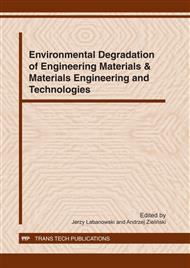p.163
p.169
p.175
p.179
p.185
p.193
p.201
p.207
p.215
Corrosion of Ni-Al and Ni-Al-Al2O3 Flame Sprayed Coatings of „CastoDyn 8000" System in 0.01 M H2SO4 and 3.5% NaCl Solutions
Abstract:
In the paper researches results of corrosion properties of Ni-Al alloy and Ni-Al-Al2O3 composite coatings were presented. Coatings were obtained by flame spraying of "Casto-Dyn 8000" torch. During coatings flame spraying of torch was used a small distance from the substrate. Instead of commonly used spray distance 150 mm, 100 mm was used. The studies in 0.01 M H2SO4 and 3.5% NaCl (artificial seawater) environments were realized. Evaluated coatings are more corrosion resistant in the 3.5% NaCl environment than in the 0.01 M H2SO4. Corrosion current density for alloy coatings in artificial seawater was 20 μA/cm2 and 223 μA/cm2 in an acidic environment. The value of corrosion potential in an environment of 3.5% NaCl is about 200 mV lower than in 0.01 M H2SO4. Composite coatings Ni-Al-Al2O3 were characterized by a lower corrosion current densities and increased resistance than Ni-Al coatings in acidic environment. The presence of alumina in the coating matrix caused increased corrosion current density in sea water environment.
Info:
Periodical:
Pages:
185-192
Citation:
Online since:
December 2011
Authors:
Price:
Сopyright:
© 2012 Trans Tech Publications Ltd. All Rights Reserved
Share:
Citation:


